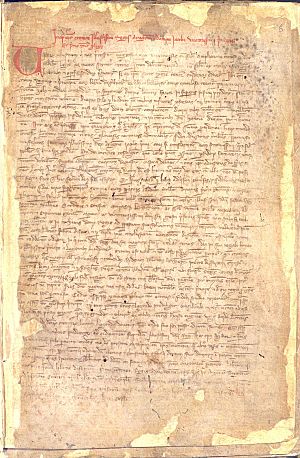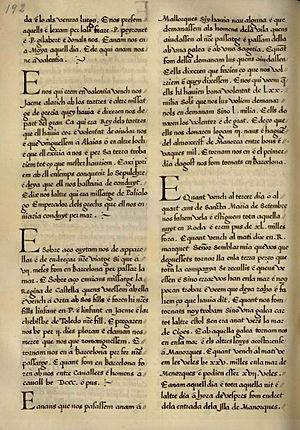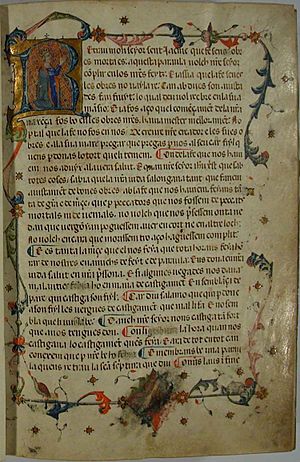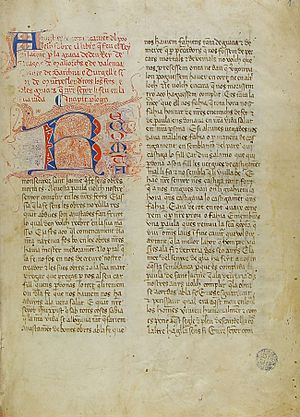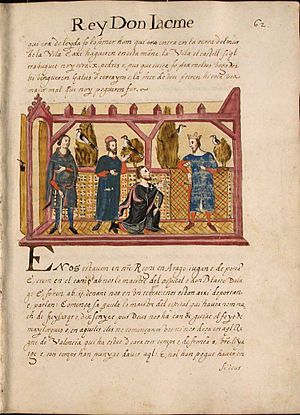Llibre dels fets facts for kids

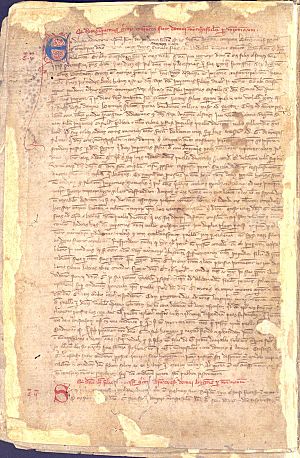
The Llibre dels fets (meaning "Book of Deeds" in Catalan) is the personal story of James I of Aragon (who ruled from 1213 to 1276). It's like his autobiography, written in Old Catalan from his own point of view. This book is the first of four important historical writings known as The Four Great Catalan Chronicles. These chronicles tell the story of the early medieval Crown of Aragon, a powerful kingdom in what is now northeastern Spain.
James I became king when he was just a child. He inherited titles like King of Aragon and Count of Barcelona. Through his conquests, he also became King of Majorca and King of Valencia. In his book, James I especially highlights his successful conquest of Majorca in 1229 and Valencia in 1238.
The book also talks about his parents: his mother, Maria of Montpellier, and his father, Peter II of Aragon. His father was known as "Peter the Catholic" because the Pope gave him that title. This was after Peter helped fight against the Moors (Muslims) in the Battle of Las Navas de Tolosa. Sadly, Peter II died fighting in the Battle of Muret. He was defending his lords in Occitania (a region in southern France) who were accused of following the Cathar heresy. He fought against Crusader troops led by Simon de Montfort, 5th Earl of Leicester.
Even though James I told his story, scribes (people who wrote by hand) did the actual writing. The book is written in a simple, everyday language, just like people spoke back then. Its style is very direct. James I's conquest of Majorca in 1229, which was controlled by the Muslim Almohads, likely inspired him to start dictating his life story. This conquest was part of the Reconquista, a long period when Christian kingdoms took back land from Muslim rule in the Iberian Peninsula. The Llibre dels fets finishes with James I's death in 1276. The original book is lost, but many old copies still exist today.
The oldest copy we have in the original Catalan language was made in 1343. It was ordered by the abbot of the Poblet Monastery. An even older copy from 1313, called "Cronice Illustrissimi Regis Aragonum", was a Latin translation of the original Catalan book. This Latin version was made by a Dominican friar named Pere Marsili. He was ordered by James II of Aragon (James I's grandson) to translate it. This way, his grandfather's story could be shared more widely, as Latin was the international language at the time.
Contents
What Makes This Book Special
The Llibre dels fets is more than just a simple history book. It's truly a "Book of Deeds," as its title suggests. Experts who studied it in the 1980s found that it has a unique style. This is because King James I spoke the entire book out loud, and royal scribes wrote down his words. This makes the book feel very informal and conversational, almost like you're hearing the king tell his story himself.
Here's a small part from the beginning of the book:
... Raconta Mon Senyor San Jaume que la fe sense obres, morta es. Aquesta paraula va voler complr Senyor en els nostres fets...
(English: ... My Lord Saint James says that faith without actions is dead. This word he wanted to fulfill, Lord, in our deeds...)
King James's writing style has some key features:
- He shows strong religious feelings.
- He expresses great love for his lands and people.
- He was directly involved in all the events he describes.
- The book has a brave and heroic military spirit.
- It uses common, everyday language.
How the Book is Organized
In the Llibre dels Fets, James I of Aragon tells the story of his life and his most important actions. These include his conquests of Valencia and Majorca from Muslim rule. The story starts with his birth in 1203 and ends with his death in 1276. The beginning and end parts of the book are written in a slightly different, more formal style. These parts were likely added or finished after his death. James was very clear about why he wrote his story:
E per tal que los hòmens coneguessen, quan hauríem passada aquesta vida mortal, ço que nós hauríem fet [...] e per dar eximpli a tots los altres hòmes del món...
(English: So that people would know, after we have passed from this life, what we have done [...] and to give an example to all other people in the world...)
In the 1313 Latin translation, Friar Pere Marsili mentioned that he translated chapters from manuscripts kept in the royal archives. This shows that the original stories already existed and were written in the common language (Catalan), not in Latin.
The oldest surviving copy in Catalan was ordered in 1343, more than 60 years after James's death. This copy was made for the Abbot of the Poblet Monastery. The Catalan text is very similar to the Latin translation. However, the Catalan version uses "we" (the majestic plural) and sometimes "I" to refer to James. The Latin version mostly uses "he" (third person). This difference suggests the Catalan copy was not made from the Latin one.
The book seems to have been created in two main parts. The first part might have been dictated around 1240, soon after James conquered Valencia. Events before 1228 are told quickly and with less detail. But from 1228 onwards, the story becomes much more detailed and accurate.
The second part was likely dictated around 1274. It also has a similar pattern: events from 1242-1265 are covered briefly, while later years are explained in great detail. The introduction and the section about his illness and death were probably written by someone close to James. Both the 1343 Catalan copy and the 1313 Latin translation share the same main story.
What the Book is About
The Llibre dels fets tells the story of James I's life and reign. It can be divided into four main sections:
- 1208–1228: This part talks about James's family, especially his parents. His mother, Maria of Montpellier, made him Lord of Montpellier. His father, Peter II of Aragon, was King of Aragon and Count of Barcelona. The book describes James's birth, which was quite unexpected. It also covers his father's tragic death at the battle of Muret in 1213. Peter II died defending his lords in Occitania against Crusader troops led by Simon de Montfort, 5th Earl of Leicester. This was part of the Cathar Crusade. The book also tells how James was captured at age 5 after his father's death. Simon de Montfort wanted James to marry his daughter, but this plan failed. James was eventually returned to Aragon. There, the Knights Templar, a powerful religious military group, raised him at Monzón Castle. This section also mentions his marriage to Eleanor of Castile.
- 1229–1240: This is the most detailed part of the book. It describes the exciting conquest of Majorca in 1229. This was a huge step for the Crown of Aragon. Soon after, James conquered Valencia in 1238. The book tries to show that King James's achievements were guided by God's will.
- 1240–1265: This section describes the conflicts James had with the Muslim rebels in Valencia.
- 1265–1276: This part again tells about battles against the Moors (Muslims). It includes the conquest of Murcia. It also explains many political events and tries to justify the king's decisions. The last chapters, which describe the king's illness and death, were probably added after James's death.
Language and Writing Style
Throughout the book, James I often explains his actions and beliefs, showing a strong religious feeling. He believed that God guided his work. The king wanted to appear as a great hero. But he didn't just write about wars and politics. He also shared small details about his daily life and even his private thoughts.
The book uses a "popular and vivid language" filled with common sayings and everyday phrases. It even includes quotes from people speaking other languages, like Aragonese, Galician-Portuguese (used in Castile), Arabic, or Old French.
Key Chapters
Here are some of the important parts of the Llibre dels fets:
- Chapter I: The Introduction.
- Chapters 2–4: About his family history.
- Chapter 5: About his birth and baptism.
- Chapters 6–7: Dedicated to his parents, King Peter II of Aragon and Maria of Montpellier.
- Chapter 8–9: The sad death of his father, King Peter II of Aragon, at the battle of Muret in 1213. He died defending his lords against the French crusaders who were invading Occitania during the Albigensian Crusade. It also tells about James I's capture by Simon de Montfort, 5th Earl of Leicester.
- Chapter 10: James I's release when he was about 6 or 7 years old.
- Chapter 11: The Cortes de Lerida (meetings in Lerida).
- Chapters 12–14: James's time at Monzón Castle, where the Knights Templar raised him.
- Chapters 15–16: The first time the nobles rebelled.
- Chapters 17–19: His wedding to Eleanor of Castile.
- Chapters 20–25: The second noble rebellion.
- Chapters 26–34: The third noble rebellion.
- Chapters 35–46: The war for the County of Urgell.
- Chapters 47–117: The exciting conquest of Majorca.
- Chapters 118–124: How the island of Menorca (part of the Balearic Islands) came under Christian rule through the Treaty of Capdepera.
- Chapters 125–126: The conquest of the island of Ibiza (also in the Balearic Islands) from Muslim rule. These three islands then formed the Christian Kingdom of Majorca.
- Chapters 127–289: The conquest of Valencia from the Moors, leading to the creation of the Kingdom of Valencia.
Copies and Editions of the Book
We have five copies of the book from the 1300s and two from the 1400s. All of these are based on a Latin translation of the original Catalan text. This translation was done by the Dominican friar Pere Marsili. He was ordered to do this by King James I's grandson, James II of Aragon. The goal was to update the original text to fit the style of the time. As the text says:
[...] So that the deeds of His glorious grandfather (James I), collected in a truthful but vulgar style, shall be put to date and once translated to Latin, form a single History volume, a full chronicle in which all the actions of the king his grandfather (James I the Conqueror) will be woven together.
Friar Pere Marsili finished this important task on April 2, 1313. He then asked the king to make a copy for the Friars Preachers of Majorca, his home island. This copy would be used on the "Feast of the Banner," a special day:
[...] with the purpose of the last day of the year, the annual feast which commemorates the conquest of the city of Majorca, for God's glory and the eternally worshiping memory of his Luckiest Prince (James I), and so the friars who preach on this significative solemn date in front of the whole clergy and people, could rely to this book, and more firmly be informed of the truth of the facts."
The official delivery of the Latin translation, called Cronice Illustrissimi Regis Aragonum domini Jacobi victorissimi principis, happened on June 2, 1314. It took place at the Church of the Friars Preachers in Valencia.
There are six official copies of Pere Marsili's Latin translation. Four are from the 14th century. They are kept in places like the National Library of Catalonia and the Archives of the Kingdom of Majorca. A copy from the 17th century is at the General Archive of the Crown of Aragon, and one from the 19th century is in the Real Academia de la Historia of Spain.
The oldest surviving copy in the original Catalan language is from 1343. It was ordered by Ponç de Copons, the abbot of the Poblet Monastery. The book mentions this:
Aquest libre féu escriure l'onrat en Ponç de Copons, per la gràcia de Déu, abbat de l'honrat monestir de Sancta Maria de Poblet, en lo qual monestir jau lo molt alt senyor En Jaume, aqueyl que aquest libre parla, dels feyts que féu ni li endevengueren en la sua vida
(English: This book was ordered by the honorable Ponç de Copons, by God's grace, abbot of the St Maria Poblet Monastery, where there lies the most high Lord Sir James, the one about whom the book tells, about the deeds and acts that he encountered in his lifetime). Friar Celestí des Torrents finished this manuscript on September 17, 1343.
This copy from Poblet Monastery was made from an original manuscript that belonged to the Royal Chancellery. On November 11, 1343, King Peter IV of Aragon sent a letter asking the abbot of Poblet Monastery to return the original book. In 1585, King Philip II of Spain visited Poblet Monastery and ordered a copy of the chronicle for the Royal Library in Madrid.
Another important Catalan copy is from 1380. This one came directly from the Royal Chancellery of King Peter IV of Aragon. It must be a direct copy of the original, as the king himself ordered Johan de Barbastro to make it. The Latin text says:
Mandato serenissimi domini petri dei gratir regis Aragonum valentiae, Majoricarum, cardinieae et Corsicae, Comitisque Barchinonae, Rossilionis et Ceritaniae [...] Ego Iohannes de Barbastro de scribania predicti domini Regis Aragonum, oriundus Cesaraugustae scripsi Ciuitate Barchinonae Anno a Nativitate Dmi. Mo. CCCo. octuagesimo sripsi
(English: By order of Peter, by God's Grace King of Aragon, Valencia, Majorca, Sardinia and Corsica, Count of Barcelona, Roussillon and Cerdanya [...] I Johan de Barbastro, scribe chosen by the King of Aragon [...] in the City of Barcelona, year of The Lord's Nativity, 1380)
Its Catalan introduction reads:
Aquest es lo començament del prolech sobre el libre que feu el rey en Jacme per la gracia de Deu rey de Arago e de Mallorches e de Valencia, comte de Barchinona e d'Urgell e senyor de Muntpesler de tots los fets e de les gracies que Nostre Senyor li féu en la sua vida
(English: This is the beginning of the prologue about the book that King James made, by Holy Grace, King of Aragon, of Majorca and Valentia, Count of Barcelona and Count of Urgell, and Lord of Montpellier, of all his deeds and gifts our Lord gave to him in his lifetime.)
An important fact about this copy is that Johan de Barbastro used an official book from the Royal Chancellery (which is now lost). King Pere IV ordered three copies: one for Majorca, one for Barcelona, and one for Valencia. Only the Majorcan copy has survived, and it is now kept in the National Library of Catalonia.
The first printed version of the book was ordered and paid for by the city of Valencia in 1557. This happened during a time when people were very interested in history. Once printed, a copy was sent to King Philip II of Spain in Madrid. He was also very interested in the old book kept at the Poblet Monastery.
Other copies of the book have survived, all based on the one made for the Poblet Monastery in 1343. One important copy is in the library of the University of Barcelona. It was made by a student named Jaume Ferrera, ordered by his teacher, Prior Jaume Ramon Vila. The Prior added his own introduction, which makes this copy special. He explained that he ordered this copy of the Llibre dels fets "to deny the false claims that Castilian historians were making against Catalans". He also noted that the illustrations in this copy are exact copies of those from the 1343 Poblet Monastery manuscript. Another unique feature of this copy is a second original illustration that was lost from the Poblet manuscript. This picture shows the Mayor of the Palace, Hugh de Forcalquier, and Blasco de Alagón kneeling before James I.
See also
 In Spanish: Llibre dels feits para niños
In Spanish: Llibre dels feits para niños



